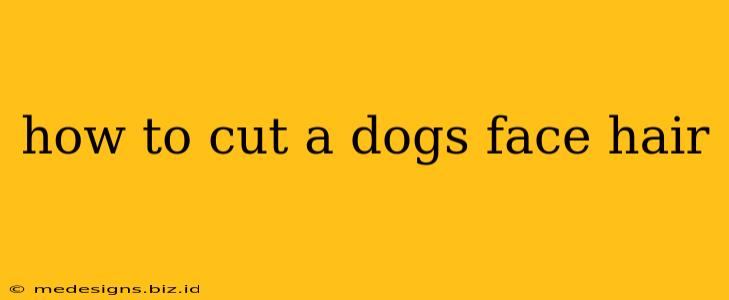Trimming your dog's face hair might seem daunting, but with the right tools and techniques, it can be a manageable and even enjoyable experience for both you and your furry friend. This guide will walk you through the process, ensuring a safe and stylish trim.
Why Trim Your Dog's Face Hair?
There are several reasons why you might want to trim your dog's face hair:
- Improved Visibility: Long hair around the eyes can obstruct your dog's vision, leading to potential accidents and discomfort.
- Hygiene: Hair around the mouth and nose can trap food, dirt, and saliva, potentially leading to irritation and infections.
- Comfort: Excessive hair can be uncomfortable, especially in hot weather.
- Aesthetics: A well-groomed face enhances your dog's overall appearance.
Essential Tools for the Job
Before you begin, gather the following tools:
- Dog-specific clippers: These are designed for sensitive canine skin and are less likely to cause irritation or injury. Look for clippers with different guard sizes for varying lengths.
- Scissors: Sharp, blunt-ended scissors are ideal for trimming around delicate areas like the eyes and nose. Avoid using sharp-pointed scissors to prevent accidental cuts.
- Comb or brush: A good quality comb or brush is essential for detangling and guiding the hair during trimming. Use a de-shedding tool if your dog has a lot of undercoat.
- Treats: Positive reinforcement is key! Keep your dog engaged and happy with plenty of tasty treats.
- Towels: Keep towels handy to clean up any stray hairs.
- Styptic powder (optional): This helps to stop any minor bleeding if your dog gets accidentally nicked.
Step-by-Step Guide to Trimming Your Dog's Face Hair
1. Preparation is Key:
- Calm Environment: Choose a quiet, well-lit space where your dog feels comfortable.
- Familiarize Your Dog: Let your dog sniff and investigate the clippers and scissors before you start.
- Brush Thoroughly: Brush your dog's face thoroughly to remove any mats or tangles.
- Positive Reinforcement: Use treats and praise to keep your dog relaxed and cooperative.
2. Trimming Around the Eyes:
- Use Scissors: This is best done with scissors, not clippers.
- Short, Controlled Snips: Make short, controlled snips, carefully working around the eyes to remove hair that obstructs vision.
- Caution is Crucial: Be extremely gentle and cautious around the eyes to avoid injury.
3. Trimming Around the Muzzle:
- Clippers or Scissors: You can use clippers with a guard or scissors for this area.
- Follow the Hairline: Follow the natural hairline to avoid an unnatural look.
- Gentle Pressure: Avoid pulling or tugging on the hair.
4. Trimming Around the Ears:
- Clean Ears First: Clean your dog's ears before trimming.
- Short Snips: Use scissors to carefully trim any excess hair around the ears.
- Avoid the Ear Canal: Do not cut hair inside the ear canal.
5. Cleaning Up:
- Brush Away Loose Hair: Once you're finished, brush away any loose hair.
- Reward Your Dog: Give your dog plenty of praise and treats for their patience.
When to Seek Professional Help:
If you are uncomfortable trimming your dog's face hair yourself, or if your dog has particularly sensitive skin or a challenging coat, it's best to seek the help of a professional groomer. They have the experience and tools to handle any situation safely and effectively.
Important Considerations:
- Breed-Specific Needs: Different breeds have different grooming needs. Research your dog's breed to understand its specific requirements.
- Sensitivity: Some dogs are more sensitive than others. If your dog seems anxious or uncomfortable, take breaks and offer plenty of reassurance.
- Patience: Be patient and take your time. Rushing the process can lead to accidents.
By following these steps and using the right tools, you can successfully trim your dog's face hair, keeping them comfortable, safe, and looking their best. Remember, safety and your dog's comfort should always be your top priorities.
